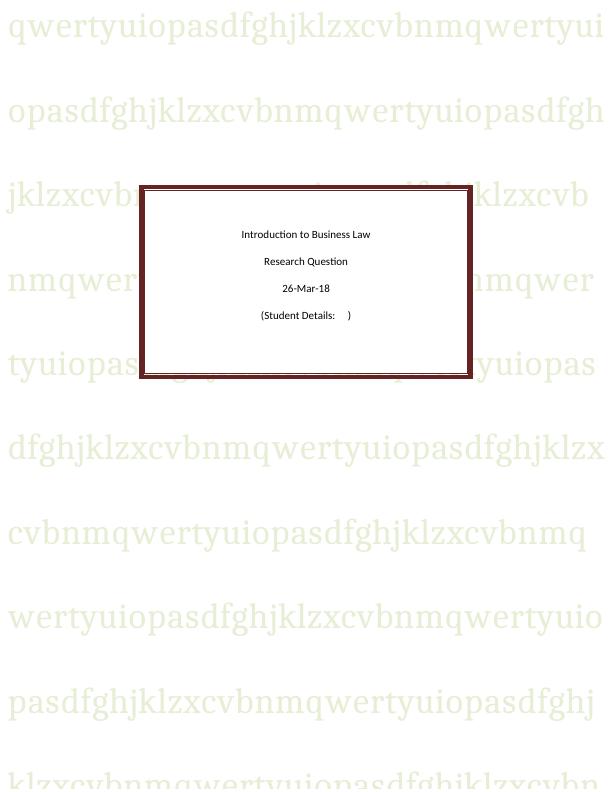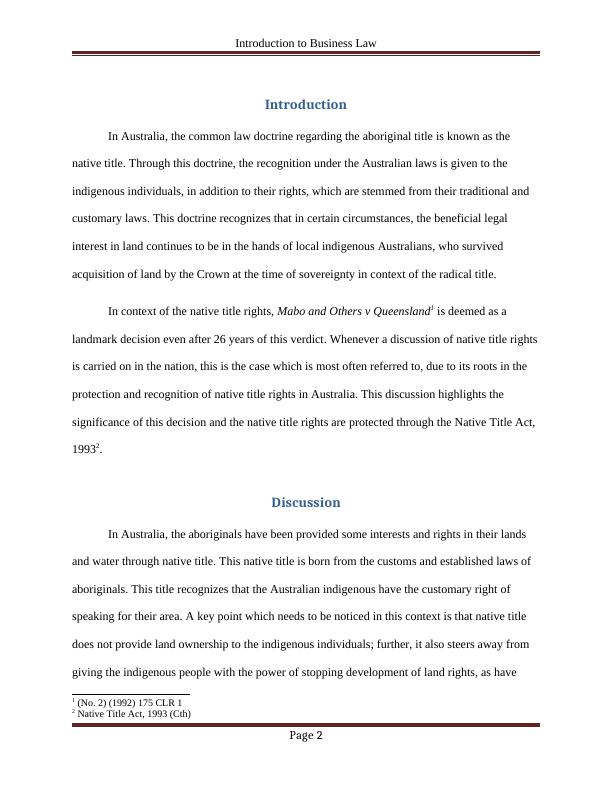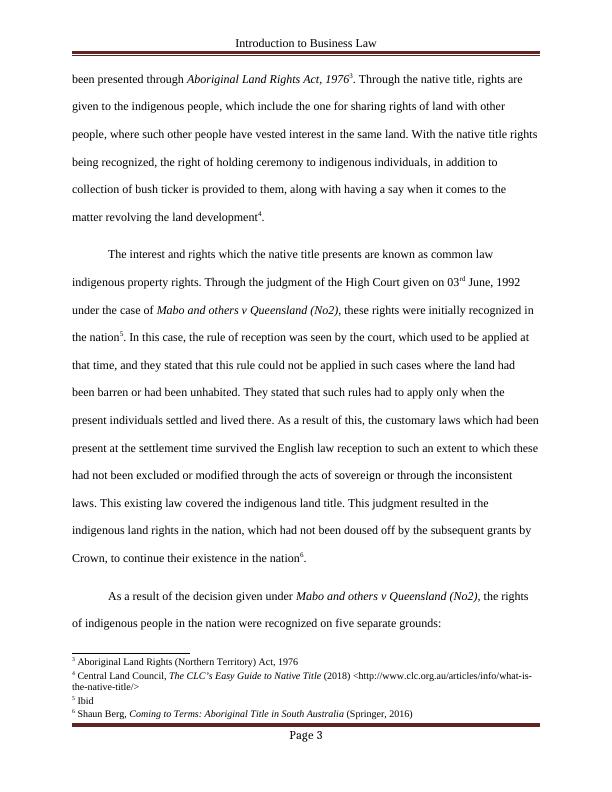Mabo and Others v Queensland: A Landmark Decision for Native Title Rights in Australia
Added on 2023-06-14
8 Pages1952 Words193 Views
qwertyuiopasdfghjklzxcvbnmqwertyui
opasdfghjklzxcvbnmqwertyuiopasdfgh
jklzxcvbnmqwertyuiopasdfghjklzxcvb
nmqwertyuiopasdfghjklzxcvbnmqwer
tyuiopasdfghjklzxcvbnmqwertyuiopas
dfghjklzxcvbnmqwertyuiopasdfghjklzx
cvbnmqwertyuiopasdfghjklzxcvbnmq
wertyuiopasdfghjklzxcvbnmqwertyuio
pasdfghjklzxcvbnmqwertyuiopasdfghj
Introduction to Business Law
Research Question
26-Mar-18
(Student Details: )
opasdfghjklzxcvbnmqwertyuiopasdfgh
jklzxcvbnmqwertyuiopasdfghjklzxcvb
nmqwertyuiopasdfghjklzxcvbnmqwer
tyuiopasdfghjklzxcvbnmqwertyuiopas
dfghjklzxcvbnmqwertyuiopasdfghjklzx
cvbnmqwertyuiopasdfghjklzxcvbnmq
wertyuiopasdfghjklzxcvbnmqwertyuio
pasdfghjklzxcvbnmqwertyuiopasdfghj
Introduction to Business Law
Research Question
26-Mar-18
(Student Details: )

Introduction to Business Law
Introduction
In Australia, the common law doctrine regarding the aboriginal title is known as the
native title. Through this doctrine, the recognition under the Australian laws is given to the
indigenous individuals, in addition to their rights, which are stemmed from their traditional and
customary laws. This doctrine recognizes that in certain circumstances, the beneficial legal
interest in land continues to be in the hands of local indigenous Australians, who survived
acquisition of land by the Crown at the time of sovereignty in context of the radical title.
In context of the native title rights, Mabo and Others v Queensland1 is deemed as a
landmark decision even after 26 years of this verdict. Whenever a discussion of native title rights
is carried on in the nation, this is the case which is most often referred to, due to its roots in the
protection and recognition of native title rights in Australia. This discussion highlights the
significance of this decision and the native title rights are protected through the Native Title Act,
19932.
Discussion
In Australia, the aboriginals have been provided some interests and rights in their lands
and water through native title. This native title is born from the customs and established laws of
aboriginals. This title recognizes that the Australian indigenous have the customary right of
speaking for their area. A key point which needs to be noticed in this context is that native title
does not provide land ownership to the indigenous individuals; further, it also steers away from
giving the indigenous people with the power of stopping development of land rights, as have
1 (No. 2) (1992) 175 CLR 1
2 Native Title Act, 1993 (Cth)
Page 2
Introduction
In Australia, the common law doctrine regarding the aboriginal title is known as the
native title. Through this doctrine, the recognition under the Australian laws is given to the
indigenous individuals, in addition to their rights, which are stemmed from their traditional and
customary laws. This doctrine recognizes that in certain circumstances, the beneficial legal
interest in land continues to be in the hands of local indigenous Australians, who survived
acquisition of land by the Crown at the time of sovereignty in context of the radical title.
In context of the native title rights, Mabo and Others v Queensland1 is deemed as a
landmark decision even after 26 years of this verdict. Whenever a discussion of native title rights
is carried on in the nation, this is the case which is most often referred to, due to its roots in the
protection and recognition of native title rights in Australia. This discussion highlights the
significance of this decision and the native title rights are protected through the Native Title Act,
19932.
Discussion
In Australia, the aboriginals have been provided some interests and rights in their lands
and water through native title. This native title is born from the customs and established laws of
aboriginals. This title recognizes that the Australian indigenous have the customary right of
speaking for their area. A key point which needs to be noticed in this context is that native title
does not provide land ownership to the indigenous individuals; further, it also steers away from
giving the indigenous people with the power of stopping development of land rights, as have
1 (No. 2) (1992) 175 CLR 1
2 Native Title Act, 1993 (Cth)
Page 2

Introduction to Business Law
been presented through Aboriginal Land Rights Act, 19763. Through the native title, rights are
given to the indigenous people, which include the one for sharing rights of land with other
people, where such other people have vested interest in the same land. With the native title rights
being recognized, the right of holding ceremony to indigenous individuals, in addition to
collection of bush ticker is provided to them, along with having a say when it comes to the
matter revolving the land development4.
The interest and rights which the native title presents are known as common law
indigenous property rights. Through the judgment of the High Court given on 03rd June, 1992
under the case of Mabo and others v Queensland (No2), these rights were initially recognized in
the nation5. In this case, the rule of reception was seen by the court, which used to be applied at
that time, and they stated that this rule could not be applied in such cases where the land had
been barren or had been unhabited. They stated that such rules had to apply only when the
present individuals settled and lived there. As a result of this, the customary laws which had been
present at the settlement time survived the English law reception to such an extent to which these
had not been excluded or modified through the acts of sovereign or through the inconsistent
laws. This existing law covered the indigenous land title. This judgment resulted in the
indigenous land rights in the nation, which had not been doused off by the subsequent grants by
Crown, to continue their existence in the nation6.
As a result of the decision given under Mabo and others v Queensland (No2), the rights
of indigenous people in the nation were recognized on five separate grounds:
3 Aboriginal Land Rights (Northern Territory) Act, 1976
4 Central Land Council, The CLC’s Easy Guide to Native Title (2018) <http://www.clc.org.au/articles/info/what-is-
the-native-title/>
5 Ibid
6 Shaun Berg, Coming to Terms: Aboriginal Title in South Australia (Springer, 2016)
Page 3
been presented through Aboriginal Land Rights Act, 19763. Through the native title, rights are
given to the indigenous people, which include the one for sharing rights of land with other
people, where such other people have vested interest in the same land. With the native title rights
being recognized, the right of holding ceremony to indigenous individuals, in addition to
collection of bush ticker is provided to them, along with having a say when it comes to the
matter revolving the land development4.
The interest and rights which the native title presents are known as common law
indigenous property rights. Through the judgment of the High Court given on 03rd June, 1992
under the case of Mabo and others v Queensland (No2), these rights were initially recognized in
the nation5. In this case, the rule of reception was seen by the court, which used to be applied at
that time, and they stated that this rule could not be applied in such cases where the land had
been barren or had been unhabited. They stated that such rules had to apply only when the
present individuals settled and lived there. As a result of this, the customary laws which had been
present at the settlement time survived the English law reception to such an extent to which these
had not been excluded or modified through the acts of sovereign or through the inconsistent
laws. This existing law covered the indigenous land title. This judgment resulted in the
indigenous land rights in the nation, which had not been doused off by the subsequent grants by
Crown, to continue their existence in the nation6.
As a result of the decision given under Mabo and others v Queensland (No2), the rights
of indigenous people in the nation were recognized on five separate grounds:
3 Aboriginal Land Rights (Northern Territory) Act, 1976
4 Central Land Council, The CLC’s Easy Guide to Native Title (2018) <http://www.clc.org.au/articles/info/what-is-
the-native-title/>
5 Ibid
6 Shaun Berg, Coming to Terms: Aboriginal Title in South Australia (Springer, 2016)
Page 3

End of preview
Want to access all the pages? Upload your documents or become a member.
Related Documents
Business Law- Mabo Case (Doc)lg...
|8
|2139
|250
The Native Title Act Research Paper 2022lg...
|10
|2102
|32
Mabo Case [No.2] and its Impact on the Australian Legal Systemlg...
|10
|2094
|294
Assignment on Property Lawlg...
|7
|1237
|56
The Mabo Decision and the Native Title Act: Benefits and Shortcomingslg...
|7
|2142
|269
Mabo and Others v Queensland (No.2) 1992 Incorporating the Native Title Act 1993 2 CONCLUSIONS 4 REFERENCES 5 INTRODUCTIONlg...
|7
|2092
|33
